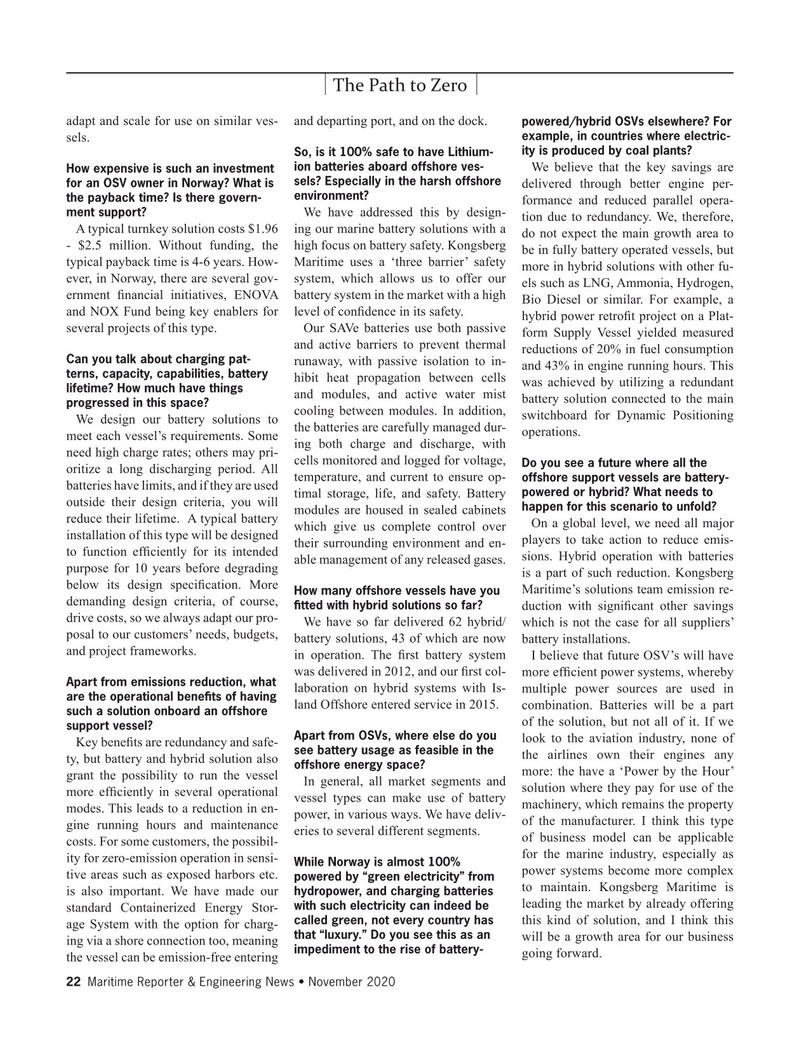
Page 22: of Maritime Reporter Magazine (November 2020)
Workboat Edition
Read this page in Pdf, Flash or Html5 edition of November 2020 Maritime Reporter Magazine
The Path to Zero adapt and scale for use on similar ves- and departing port, and on the dock.
powered/hybrid OSVs elsewhere? For example, in countries where electric- sels.
ity is produced by coal plants?
So, is it 100% safe to have Lithium- ion batteries aboard offshore ves-
We believe that the key savings are
How expensive is such an investment sels? Especially in the harsh offshore for an OSV owner in Norway? What is delivered through better engine per- environment? the payback time? Is there govern- formance and reduced parallel opera- ment support?
We have addressed this by design- tion due to redundancy. We, therefore,
A typical turnkey solution costs $1.96 ing our marine battery solutions with a do not expect the main growth area to - $2.5 million. Without funding, the high focus on battery safety. Kongsberg be in fully battery operated vessels, but typical payback time is 4-6 years. How- Maritime uses a ‘three barrier’ safety more in hybrid solutions with other fu- ever, in Norway, there are several gov- system, which allows us to offer our els such as LNG, Ammonia, Hydrogen, ernment ? nancial initiatives, ENOVA battery system in the market with a high
Bio Diesel or similar. For example, a and NOX Fund being key enablers for level of con? dence in its safety.
hybrid power retro? t project on a Plat- several projects of this type. Our SAVe batteries use both passive form Supply Vessel yielded measured and active barriers to prevent thermal reductions of 20% in fuel consumption
Can you talk about charging pat- runaway, with passive isolation to in- and 43% in engine running hours. This terns, capacity, capabilities, battery hibit heat propagation between cells was achieved by utilizing a redundant lifetime? How much have things and modules, and active water mist battery solution connected to the main progressed in this space?
We design our battery solutions to cooling between modules. In addition, switchboard for Dynamic Positioning the batteries are carefully managed dur- operations.
meet each vessel’s requirements. Some ing both charge and discharge, with need high charge rates; others may pri-
Do you see a future where all the oritize a long discharging period. All cells monitored and logged for voltage, temperature, and current to ensure op- offshore support vessels are battery- batteries have limits, and if they are used powered or hybrid? What needs to outside their design criteria, you will timal storage, life, and safety. Battery happen for this scenario to unfold?
modules are housed in sealed cabinets reduce their lifetime. A typical battery
On a global level, we need all major which give us complete control over installation of this type will be designed players to take action to reduce emis- their surrounding environment and en- to function ef? ciently for its intended able management of any released gases.
sions. Hybrid operation with batteries purpose for 10 years before degrading is a part of such reduction. Kongsberg below its design speci? cation. More
Maritime’s solutions team emission re-
How many offshore vessels have you demanding design criteria, of course, ? tted with hybrid solutions so far? duction with signi? cant other savings drive costs, so we always adapt our pro-
We have so far delivered 62 hybrid/ which is not the case for all suppliers’ posal to our customers’ needs, budgets, battery solutions, 43 of which are now battery installations.
and project frameworks. in operation. The ? rst battery system I believe that future OSV’s will have was delivered in 2012, and our ? rst col- more ef? cient power systems, whereby
Apart from emissions reduction, what laboration on hybrid systems with Is- multiple power sources are used in are the operational bene? ts of having land Offshore entered service in 2015. combination. Batteries will be a part such a solution onboard an offshore of the solution, but not all of it. If we support vessel?
Apart from OSVs, where else do you look to the aviation industry, none of
Key bene? ts are redundancy and safe- see battery usage as feasible in the the airlines own their engines any ty, but battery and hybrid solution also offshore energy space? more: the have a ‘Power by the Hour’ grant the possibility to run the vessel
In general, all market segments and solution where they pay for use of the more ef? ciently in several operational vessel types can make use of battery machinery, which remains the property modes. This leads to a reduction in en- power, in various ways. We have deliv- of the manufacturer. I think this type gine running hours and maintenance eries to several different segments. of business model can be applicable costs. For some customers, the possibil- for the marine industry, especially as ity for zero-emission operation in sensi-
While Norway is almost 100% power systems become more complex tive areas such as exposed harbors etc. powered by “green electricity” from to maintain. Kongsberg Maritime is hydropower, and charging batteries is also important. We have made our leading the market by already offering with such electricity can indeed be standard Containerized Energy Stor- this kind of solution, and I think this called green, not every country has age System with the option for charg- that “luxury.” Do you see this as an will be a growth area for our business ing via a shore connection too, meaning impediment to the rise of battery- going forward.
the vessel can be emission-free entering 22 Maritime Reporter & Engineering News • November 2020
MR #11 (18-33).indd 22 11/9/2020 9:32:52 AM

 21
21

 23
23
